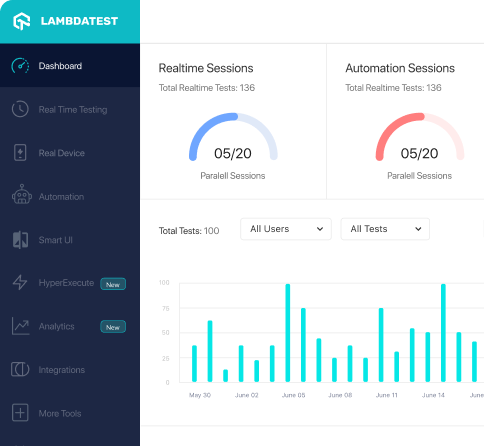How to use HttpProfilerLogEntry class of org.openqa.selenium.logging.profiler package
Best Selenium code snippet using org.openqa.selenium.logging.profiler.HttpProfilerLogEntry
Source:HttpProfilerLogEntry.java
1package org.openqa.selenium.logging.profiler;2import com.google.common.collect.ImmutableMap;3import com.google.gson.Gson;4import java.util.Map;5public class HttpProfilerLogEntry6 extends ProfilerLogEntry7{8 public HttpProfilerLogEntry(String commandName, boolean isStart)9 {10 super(EventType.HTTP_COMMAND, constructMessage(EventType.HTTP_COMMAND, commandName, isStart));11 }12 13 private static String constructMessage(EventType eventType, String commandName, boolean isStart) {14 Map<String, ?> map = ImmutableMap.of("event", eventType15 .toString(), "command", commandName, "startorend", isStart ? "start" : "end");16 17 return new Gson().toJson(map);18 }19}...HttpProfilerLogEntry
Using AI Code Generation
1import org.openqa.selenium.logging.profiler.HttpProfilerLogEntry;2import org.openqa.selenium.logging.profiler.HttpProfilerLogEntry.HttpProfilerLogEntryType;3public class HttpProfilerLogEntryExample {4 public static void main(String[] args) {5 System.out.println("Log entry type: " + logEntry.getType());6 System.out.println("Log entry message: " + logEntry.getMessage());7 }8}9from org.openqa.selenium.logging.profiler import HttpProfilerLogEntry10from org.openqa.selenium.logging.profiler import HttpProfilerLogEntryType11def main(args):12 print "Log entry type: " + logEntry.getType()13 print "Log entry message: " + logEntry.getMessage()14 main(sys.argv[1:])15def main(args)16 puts "Log entry type: " + logEntry.getType()17 puts "Log entry message: " + logEntry.getMessage()18main(ARGV)19use org.openqa.selenium\logging\profiler\HttpProfilerLogEntry;HttpProfilerLogEntry
Using AI Code Generation
1package org.openqa.selenium.logging.profiler;2import static org.openqa.selenium.logging.profiler.HttpProfilerLogType.BROWSER;3import static org.openqa.selenium.logging.profiler.HttpProfilerLogType.DRIVER;4import static org.openqa.selenium.logging.profiler.HttpProfilerLogType.SERVER;5import org.junit.After;6import org.junit.Before;7import org.junit.Test;8import org.openqa.selenium.By;9import org.openqa.selenium.WebDriver;10import org.openqa.selenium.WebElement;11import org.openqa.selenium.chrome.ChromeDriver;12import org.openqa.selenium.logging.LogEntry;13import org.openqa.selenium.logging.LogType;14import org.openqa.selenium.logging.Logs;15import java.util.List;16public class HttpProfilerTest {17 private WebDriver driver;18 public void setUp() {19 driver = new ChromeDriver();20 }21 public void tearDown() {22 driver.quit();23 }24 public void testHttpProfiler() {25 WebElement element = driver.findElement(By.name("q"));26 element.sendKeys("Cheese");27 element.submit();28 Logs logs = driver.manage().logs();29 List<LogEntry> browserEntries = logs.get(BROWSER).getAll();30 List<LogEntry> driverEntries = logs.get(DRIVER).getAll();31 List<LogEntry> serverEntries = logs.get(SERVER).getAll();32 for (LogEntry entry : browserEntries) {33 HttpProfilerLogEntry httpProfilerLogEntry = new HttpProfilerLogEntry(entry);34 System.out.println(httpProfilerLogEntry);35 }36 for (LogEntry entry : driverEntries) {37 HttpProfilerLogEntry httpProfilerLogEntry = new HttpProfilerLogEntry(entry);38 System.out.println(httpProfilerLogEntry);39 }40 for (LogEntry entry : serverEntries) {41 HttpProfilerLogEntry httpProfilerLogEntry = new HttpProfilerLogEntry(entry);42 System.out.println(httpProfilerLogEntry);43 }44 List<LogEntry> allEntries = logs.get(LogType.PERFORMANCE).getAll();45 for (LogEntry entry : allEntries) {46 HttpProfilerLogEntry httpProfilerLogEntry = new HttpProfilerLogEntry(entry);47 System.out.println(httpProfilerLogEntry);48 }49 }50}HttpProfilerLogEntry
Using AI Code Generation
1import org.openqa.selenium.logging.profiler.HttpProfilerLogEntry;2import org.openqa.selenium.logging.profiler.HttpProfilerLogEntry;3import java.util.List;4public class ProfilerLogEntryTest {5 public static void main(String[] args) {6 List<HttpProfilerLogEntry> logEntries = driver.manage().logs().get("profiler").getAll().stream()7 .map(HttpProfilerLogEntry::fromLogEntry)8 .collect(Collectors.toList());9 }10}11import org.openqa.selenium.logging.profiler.HttpProfilerLogEntry;12import org.openqa.selenium.logging.profiler.HttpProfilerLogEntry;13import java.util.List;14public class ProfilerLogEntryTest {15 public static void main(String[] args) {16 List<HttpProfilerLogEntry> logEntries = driver.manage().logs().get("profiler").getAll().stream()17 .map(HttpProfilerLogEntry::fromLogEntry)18 .collect(Collectors.toList());19 }20}21import org.openqa.selenium.logging.profiler.HttpProfilerLogEntry;22import org.openqa.selenium.logging.profiler.HttpProfilerLogEntry;23import java.util.List;24public class ProfilerLogEntryTest {25 public static void main(String[] args) {26 List<HttpProfilerLogEntry> logEntries = driver.manage().logs().get("profiler").getAll().stream()27 .map(HttpProfilerLogEntry::fromLogEntry)28 .collect(Collectors.toList());29 }30}31import org.openqa.selenium.logging.profiler.HttpProfilerLogEntry;32import org.openqa.selenium.logging.profiler.HttpProfilerLogEntry;33import java.util.List;34public class ProfilerLogEntryTest {35 public static void main(String[] args) {36 List<HttpProfilerLogEntry> logEntries = driver.manage().logs().get("profiler").getAll().stream()37 .map(HttpProfilerLogEntry::fromLogEntry)38 .collect(Collectors.toList());39 }40}41import org.openqa.selenium.logging.profiler.HttpProfilerLogEntry;42import org.openqa.selenium.logging.profiler.HttpProfilerLogEntry;43import java.util.List;44public class ProfilerLogEntryTest {45 public static void main(String[] args) {HttpProfilerLogEntry
Using AI Code Generation
1HttpProfilerLogEntry profilerLogEntry = new HttpProfilerLogEntry();2String profilerLog = profilerLogEntry.getLog();3System.out.println("Profiler log: " + profilerLog);4HttpProfilerLogEntry profilerLogEntry = new HttpProfilerLogEntry();5String profilerLog = profilerLogEntry.getLog();6System.out.println("Profiler log: " + profilerLog);7HttpProfilerLogEntry profilerLogEntry = new HttpProfilerLogEntry();8String profilerLog = profilerLogEntry.getLog();9System.out.println("Profiler log: " + profilerLog);10HttpProfilerLogEntry profilerLogEntry = new HttpProfilerLogEntry();11String profilerLog = profilerLogEntry.getLog();12System.out.println("Profiler log: " + profilerLog);13HttpProfilerLogEntry profilerLogEntry = new HttpProfilerLogEntry();14String profilerLog = profilerLogEntry.getLog();15System.out.println("Profiler log: " + profilerLog);16HttpProfilerLogEntry profilerLogEntry = new HttpProfilerLogEntry();17String profilerLog = profilerLogEntry.getLog();18System.out.println("Profiler log: " + profilerLog);19HttpProfilerLogEntry profilerLogEntry = new HttpProfilerLogEntry();20String profilerLog = profilerLogEntry.getLog();21System.out.println("Profiler log: " + profilerLog);22HttpProfilerLogEntry profilerLogEntry = new HttpProfilerLogEntry();23String profilerLog = profilerLogEntry.getLog();24System.out.println("Profiler log: " + profilerLog);25HttpProfilerLogEntry profilerLogEntry = new HttpProfilerLogEntry();Selenium 4 Tutorial:
LambdaTest’s Selenium 4 tutorial is covering every aspects of Selenium 4 testing with examples and best practices. Here you will learn basics, such as how to upgrade from Selenium 3 to Selenium 4, to some advanced concepts, such as Relative locators and Selenium Grid 4 for Distributed testing. Also will learn new features of Selenium 4, such as capturing screenshots of specific elements, opening a new tab or window on the browser, and new protocol adoptions.
Chapters:
-
Upgrading From Selenium 3 To Selenium 4?: In this chapter, learn in detail how to update Selenium 3 to Selenium 4 for Java binding. Also, learn how to upgrade while using different build tools such as Maven or Gradle and get comprehensive guidance for upgrading Selenium.
-
What’s New In Selenium 4 & What’s Being Deprecated? : Get all information about new implementations in Selenium 4, such as W3S protocol adaption, Optimized Selenium Grid, and Enhanced Selenium IDE. Also, learn what is deprecated for Selenium 4, such as DesiredCapabilites and FindsBy methods, etc.
-
Selenium 4 With Python: Selenium supports all major languages, such as Python, C#, Ruby, and JavaScript. In this chapter, learn how to install Selenium 4 for Python and the features of Python in Selenium 4, such as Relative locators, Browser manipulation, and Chrom DevTool protocol.
-
Selenium 4 Is Now W3C Compliant: JSON Wireframe protocol is retiring from Selenium 4, and they are adopting W3C protocol to learn in detail about the advantages and impact of these changes.
-
How To Use Selenium 4 Relative Locator? : Selenium 4 came with new features such as Relative Locators that allow constructing locators with reference and easily located constructors nearby. Get to know its different use cases with examples.
-
Selenium Grid 4 Tutorial For Distributed Testing: Selenium Grid 4 allows you to perform tests over different browsers, OS, and device combinations. It also enables parallel execution browser testing, reads up on various features of Selenium Grid 4 and how to download it, and runs a test on Selenium Grid 4 with best practices.
-
Selenium Video Tutorials: Binge on video tutorials on Selenium by industry experts to get step-by-step direction from automating basic to complex test scenarios with Selenium.
Selenium 101 certifications:
LambdaTest also provides certification for Selenium testing to accelerate your career in Selenium automation testing.
Try LambdaTest Now !!
Get 100 minutes of automation test minutes FREE!!



